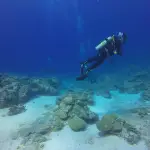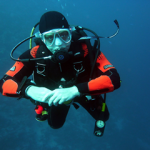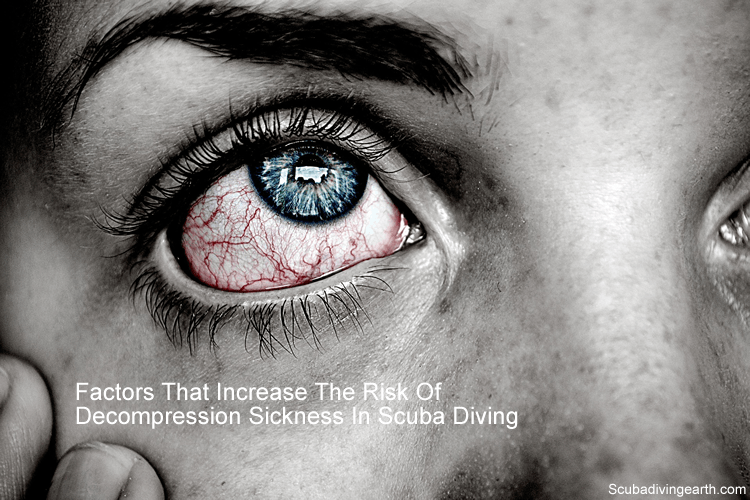
One risk you want to avoid when scuba diving is decompression sickness
Decompression sickness or ‘The Bends‘ is a potentially fatal affliction that can affect scuba divers. This is particularly if divers don’t follow safe diving practices and procedures.
What increases the risk of decompression sickness and decompression sickness risk
- The number and depth of your previous dives.
- Your age and being older than 30.
- Cardiovascular fitness.
- Physical exertion when diving.
- Obesity with a high percentage of body fat.
- Smoking and other drugs.
- Excessive alcohol consumption.
- Fatigue and a lack of sleep.
- Dehydration.
- Injuries or birth defects including both atrial septal defect and ventricular septal defects.
- Flying too soon after a dive.
- Being female during the menstrual cycle.
- Cold water diving.
- Lung disease.
The best way to do more diving is to book yourself on a scuba diving liveaboard. You can check the latest and best deals on liveaboards using the following window:
Think carefully about your personal circumstances before simply relying on decompression tables or your dive computer.
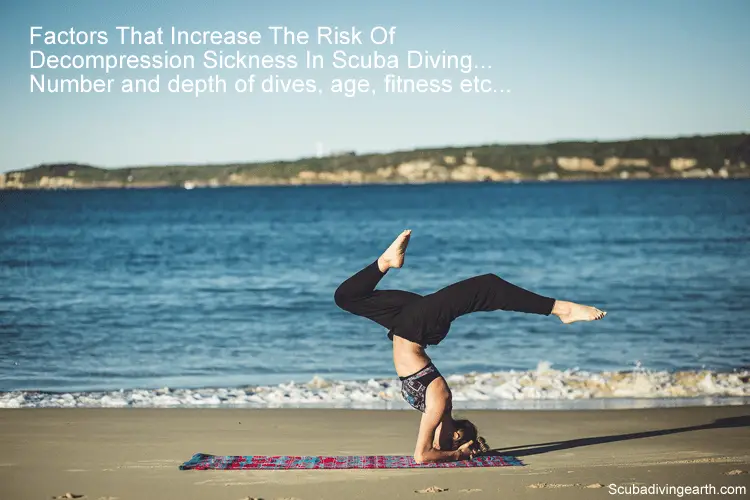
14 decompression sickness risk factors in scuba diving
There are many factors that increase the risk of decompression sickness in scuba diving. This article aims to highlight what these risk factors are and what to do to minimise them for you.
Each diving organisation like BSAC, PADI, NAUI have their own scuba diving tables you should follow. But most beginner scuba divers learn the decompression tables for the organisation they train with, only to ditch these tables for a dive computer.
Age, fitness, exertion, obesity, smoking, alcohol consumption, fatigue, dehydration and injuries can all make decompression illness more likely. You should be aware of these factors and take them into account by diving conservatively and not pushing the limits of your chosen decompression computer or table.
British Sub Aqua Club
The biggest dangers divers face when scuba diving is themselves. Which means the majority of all the risks associated with scuba diving, land fair and squarely at your feet. This means that the good thing about most of these risks are you are in control of each one that applies to you.

Making scuba diving safe from the risk of decompression sickness
As you are in control of the scuba diving decompression risk factors, and if you follow my 107 top tips for beginner scuba divers, you’ll make scuba diving safe.
The Divers Alert Network comments that around 1,000 US scuba divers are affected by decompression illness each year. Please don’t be one their statistics.
Recreational divers should dive conservatively, whether they are using dive tables or computers. Experienced divers often select a table depth (versus actual depth) of 10 feet (3 meters) deeper than called for by standard procedure.
Diver’s Alert Network
BSAC list the majority of these decompression sickness risk factors in their safe diving guide. But in my article I go into more detail with a few added risk factors. But first let me explain what causes decompression sickness in scuba divers.
What causes decompression sickness in scuba divers
The cause of decompression sickness also known as the bends, is caused by nitrogen bubbles forming in the bloodstream and tissues of the body.
These nitrogen bubbles form if you ascend too quickly from deep water at the end of a dive. Decompression sickness also occurs if you fail to carry out decompression stops at the appropriate depth and for the correct time on your ascent.
The reason why bubbles form is because the pressure of the surrounding water decreases as you ascend. If this pressure falls too quickly (i.e due to a fast ascent or an ascent without the required decompression stops), the dissolved nitrogen is released too quickly and forms potentially deadly bubbles.
If however you ascend at the correct ascent rate and carry out the correct decompression stops, the nitrogen is released slowly enough that these nitrogen bubbles don’t form. The best way to control your ascent safely is to use a dive computer.
So here is my list of 14 decompression sickness risk factors and in each case how to avoid the risk:
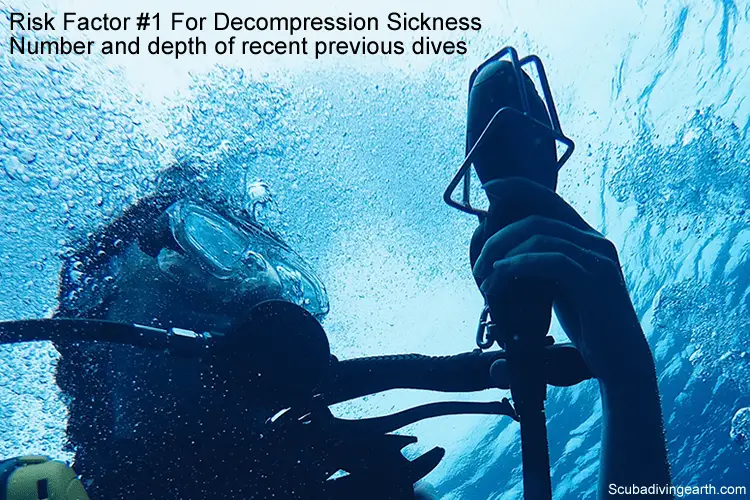
1. The number and depth of recent dives will affect your risk of decompression Sickness
If you are using BSAC tables, BSAC recommends you should not conduct more than three dives in one day, and that if you are diving deeper than 30m you should take a 24-hour break after diving for four consecutive days.
British Sub Aqua Club
If you use BSAC diving tables they recommend you shouldn’t dive more than three scuba dives in one day. BSAC also recommend that if you are diving deeper than 30 metres (100 feet) you should take a 24-hour break after diving for four consecutive days.
The message in this is to be careful with the number of dives you do each day. Plus when you’re diving deeper give your body a rest. This will allow your tissues to properly decompress and release the built-up nitrogen.
Liveaboard diving presents the opportunity to do more dives per day
Liveaboards offer an opportunity to dive up to 5 times per day. Whilst this is a great way for beginner divers to build up their diving experience, it may not be safe to dive that often every day.
If you are a beginner scuba diver you may like to read this article about the 10 best liveaboards for beginner divers.
On some liveaboard trips, including liveaboard trips to Socorro Island to see manta rays, they allow up to four dives per day.
The choice of how many dives you do each day. Plus the depth of the dives you do is entirely your choice.
However, on trips like the one to Socorro Island or a liveaboard to the Cocos Islands and Mergui Archipelago involves ‘remote scuba diving.’ This means that should anything go wrong you’re a long way from land and a hospital. But more importantly, a long distance from a recompression chamber or hyperbaric chamber.
Although, one of the liveaboards that visits Socorro Island has a recompression chamber on board. But that’s not to say you want to put it through its paces.
How to avoid decompression sickness risk factor #1
In order to avoid the first decompression risk factor is to be careful about how many dives you do each day. Also, consider taking a ‘scuba diving break’ to help reduce the nitrogen build-up.
If you are diving from a dive liveaboard take time out to read a book or review your photos and videos.
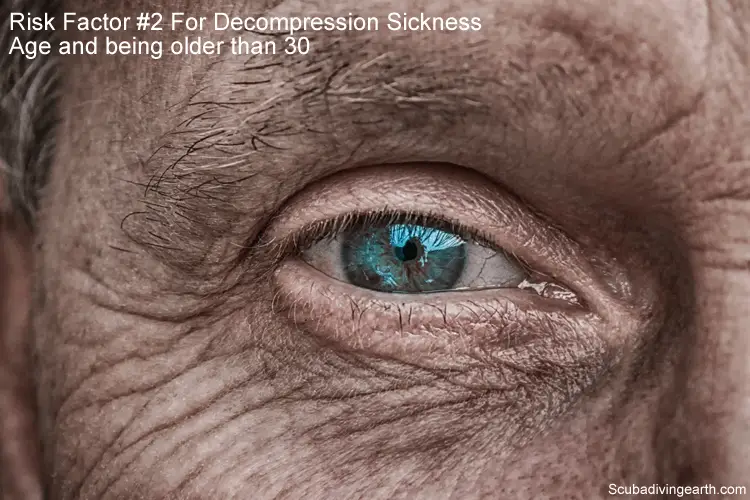
2. Age and being older than 30 are decompression risk factors
Unfortunately, age gets to us all. It’s a well known fact that as you get older your body no longer responds quite how it did when you were younger. If you exercise for example, it takes longer to recover from exercise as you get older. But exercise in itself gets harder too once you’re the wrong side of 30!
What this all boils down to is that as you age your body becomes less efficient at its automatic processes. Your bodily tissues get tired more quickly. Your tissues are also less likely to decompress as quickly as they did when you were younger.
How to avoid the risk of decompression sickness due to diving when older
If you are the wrong side of 30, 40 or 50 you should:
- Take more time with your ascent rate.
- Reduce your bottom times for no stop dives.
- Be conservative.
- Use nitrox when you dive too. Nitrox diving increases the percentage of oxygen in your air. Nitrox limits your dive depth. But then in my opinion that’s not a bad thing as you age.
- Make sure you do a three minute safety stop on every dive at between 5-6 metres (16-20 feet).
3. Low cardiovascular fitness can increase the risk of decompression sickness
The fitter your body, the better it will be at releasing the built-up nitrogen in your tissues. The converse is true and the less fit you are the slower your tissues will release the nitrogen as you decompress on your ascent from your dive.
Whilst scuba diving doesn’t require you to be ultra fit, you would benefit by being fitter than not.
Scuba diving itself is a calorie burner. Diving can burn up to 600 calories per hour. But to get the most out of scuba diving, I suggest you look after yourself out of the water too.
Being fit will also help you with your air consumption too. This in turn will give you more time underwater on each dive, as your air will last longer.
How to avoid decompression sickness risk factor #3
If you consider yourself to be unfit you may either wish to get fit. Or take your ‘unfitness‘ into account when planning your dive time and dive ascent.
You want your body to be efficient at releasing nitrogen so you reduce the risk of decompression sickness.
Solution for getting fit for scuba diving includes:
Workout Finishers – Expert Mike Whitfield introduces his breakthrough “Metabolic Stacking” training to help you torch body fat and smash any plateau in as little as 3 minutes without EVER stepping on a treadmill again.
lGet Fit For Scuba Diving Today
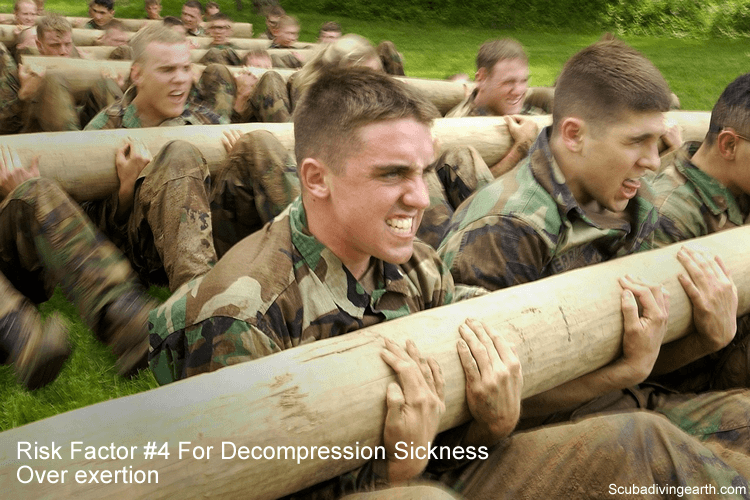
4. Over physical exertion on the dive can increase your risk of decompression sickness
Scuba diving is supposed to be effortless. When you immerse yourself and dive you become weightless. You want to use as little energy as possible, conserve your air for as long as possible and not exert yourself too much.
That being said there are times when you may exert yourself more times than others when scuba diving. An example of this is swimming against a current. When you scuba diving in a current or what’s known as drift diving, you are supposed to go with the current.
However, there may be times you have to swim against the current. If this is the case you will be exerting yourself much more than normal.
This will not only mean you use up more air, but it may have an impact on the amount of nitrogen you build-up in your body too.
That means you must be more careful with your dive time and decompression time or stops. This includes carrying out a safety stop when you’ve exerted yourself more than normal.
How to avoid decompression sickness risk factor #4
The best way to avoid the risks associated with over exertion when scuba diving is to take everything slowly and calmly.
If you are in a current where possible and when circumstances allow, always go with the current. Don’t attempt to swim against the current.
If however during the course of your dive you have over exerted yourself for whatever reason, to avoid the possibility of getting decompression sickness on your ascent, take extra time to ascend.
But be careful with your air supply, because during your over exertion you will have consumed much more of you air than usual. This will mean you need to make sure you have enough air left to ascend and to carry out your decompression stops, where applicable, and your safety stop.
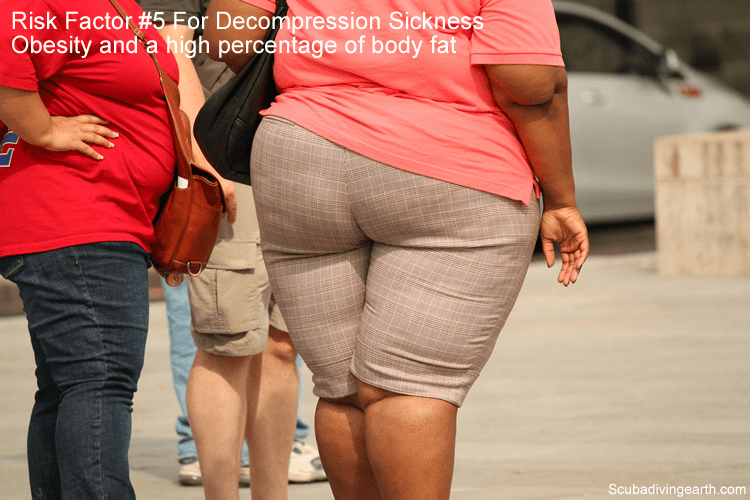
5. Obesity and a high percentage of body fat increases your risk of decompression sickness
If you suffer from obesity and you are over weight this may have an impact on the amount of time it takes to decompress on your diving ascent.
If you have an obese body it makes sense that you have more body tissues than the average person. This may have an impact on the amount of nitrogen you adsorb and on how long it takes for it to off-gas from your body.
I therefore suggest you are more careful than the average scuba diver when you plan your ascent rate and dive times. Be more conservative with your approach.
How to avoid decompression sickness risk factor #5
If you don’t want to limit your dive times or make allowances on your ascent rates you may want to consider losing weight.
One possible solution is to lose weight is using this Workout Finishers course:
Workout Finishers – Expert Mike Whitfield introduces his breakthrough “Metabolic Stacking” training to help you torch body fat and smash any plateau in as little as 3 minutes without EVER stepping on a treadmill again.
Get Fit For Scuba Diving Today

6. Smoking, tobacco or other drugs may increase your risk of decompression sickness
I don’t want this article to come across as a ‘bash the scuba diving smokers‘ type of article. But I do want to highlight the potential added risk you take by combining scuba diving and smoking.
I would also include in this category of risks; the use of other recreational drugs. It probably goes without saying that the use of drugs cannot be good for you when scuba diving. But I will focus more on smoking and tobacco for this article.
Smoking has many effects on your body, as detailed by the UK’s NHS’s smoking health problems.
The health problems directly associated with scuba diving in this article include reduced efficiency of your circulation, damage to your heart and damage to your lungs.
All of these factors will affect how efficient your body will be at releasing and expelling nitrogen in your bodily tissues. The same may be true of vaping when scuba diving.
How to avoid decompression sickness risk factor #6
To avoid the risks of scuba diving if you’re a smoker you need to be mindful of the types, depths and lengths of your dives.
A better solution would be to quit smoking altogether. Combine this with getting fit and you’re good to go!
I know I said that this article wasn’t about bashing you if you are a smoker. But I didn’t say it wasn’t going to be about encouraging you to quit smoking. I mean well!
If you’ve been considering the idea of quitting smoking, here’s a solution for you to quit today.
Quit Smoking Magic – Discover How to Quit Smoking in as Little as 7 Days, Even if You’ve been a Chain Smoker for the Past 20 Years – with No Relapses, No extra MONEY Needed, anda 98% Success Rate, Guaranteed!
98% Success Rate Program For Smoking Cessation
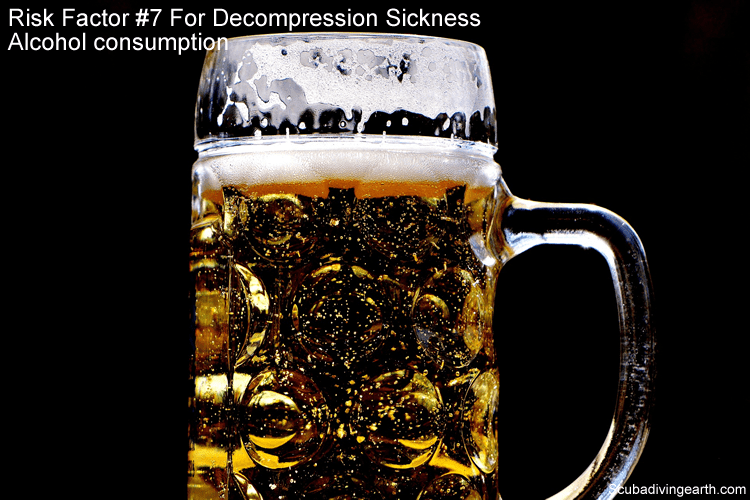
7. Excessive alcohol consumption may increase your risk of decompression sickness
When it comes to alcohol, I’d say everything in moderation. There’s nothing that says you can’t drink alcohol before you scuba dive. But I’ve was always taught to keep my drinking to a minimum the night before going scuba diving.
I’d suggest you don’t get completely paralytic or stone drunk the night before you are going to scuba dive. I’d say this is particularly more important if you intend to dive deeper than 20 plus metres (66 plus feet).
The deeper you dive the greater the risks of decompression sickness. This not only includes your body’s ability to release the nitrogen from your body as you decompress, but it also includes having a clear mind.
If you’re suffering from a hangover from the night before, you are putting yourself and your dive buddy at more risk.
More Reading: Diving Buddy Check Acronym or Mnemonic (Why Scuba Buddy Checking Is Important)
How to avoid decompression sickness risk factor #7
Be a safe diver and limit your alcohol intake the night before you scuba dive. But if you find you’ve had a skin-full you might be better off postponing your dive and/or limiting the depth you go on that day.
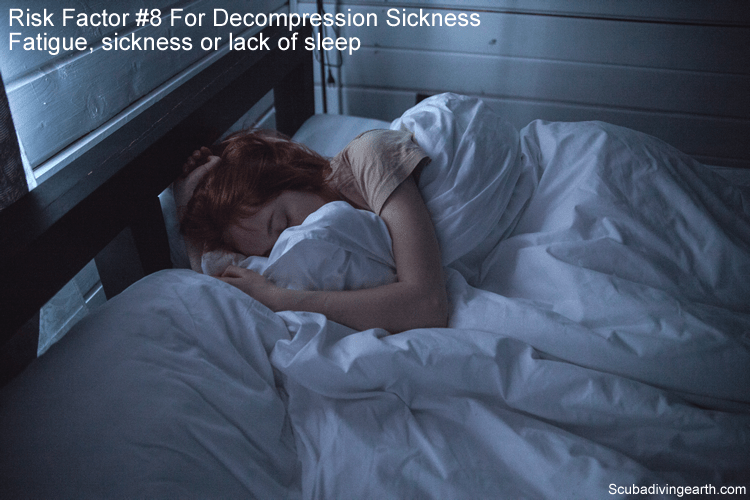
8. Fatigue, sickness or lack of sleep can increase your risk of decompression sickness
Fatigue is one of the factors that BSAC include in their list of risks that make decompression illness more likely is. This would include the lack of sleep and sickness.
How to avoid decompression sickness risk factor #8
Before your next day’s diving it’s a good idea to get a good night’s sleep. Make sure you are not overly tired and you are free from major sickness.
Diving when your body is rested and free from sickness will not only improve your body’s ability to decompress, but it will help you to not make mistakes when scuba diving too.
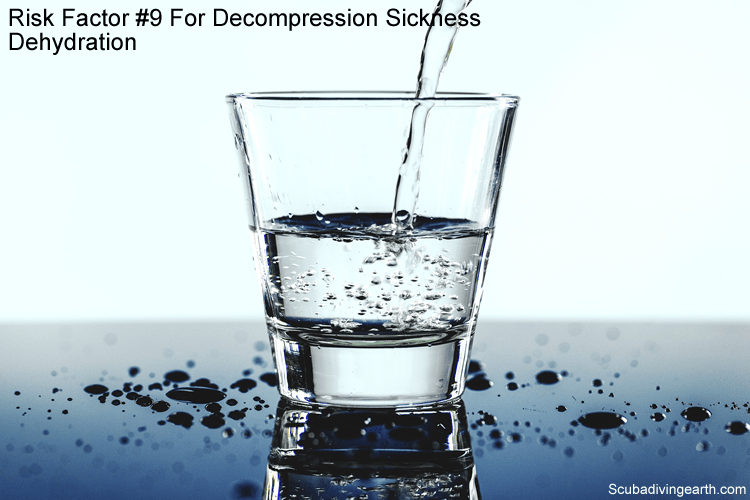
9. Dehydration can increase your risk of decompression sickness
Most diving organisations and dive companies will always encourage you to keep hydrated when scuba diving. If your body and your bodily tissues are well hydrated they will perform better. Which includes decompressing on your ascent from a dive.
I’m no scientist. Nor am I a doctor. But it makes complete sense that in order for your cells to work efficiently they need to be fully hydrated.
How to avoid decompression sickness risk factor #10
The easiest way to avoid any risks associated with dehydration is to drink plenty of water before and after each dive. This will ensure you maintain a good level of hydration.
10. Injuries or birth defects including atrial septal defect and ventricular septal defect increase your risk of decompression sickness
Scuba divers with an abnormal hole or opening in the heart from a birth defect are at a high risk of developing serious symptoms from decompression illness than those without any abnormalities.
Hole in the heart types:
- Atrial septal defects (ASD): These are located between the heart’s upper chambers (atria or atriums), which receive blood from the body (from the right atrium) and lungs (from the left atrium).
- Ventricular septal defects (VSD): These are located between the lower heart chambers (ventricles), which pump blood to the body (from the left ventricle) and to the lungs (from the right ventricle).
I’ve been witness to a hole in the heart defect at one of my old BSAC diving clubs. In fact two members of my old club discovered they had a hole in the heart (or congenital heart disease), as a result of being affected by decompression illness.
In both cases the decompression illness was a minor skin bend. But never the less it was decompression sickness. It’s better to discover the defect with minor decompression sickness than to have a serious problem from depth.
How to avoid decompression sickness risk factor #10
If you are worried you may have a birth defect, it’s very simple to be checked for a congenital heart defect.
Go to your doctor and ask them to put you in for a check. If it turns out you have a ‘hole in the heart,’ this is a simple procedure to correct. Which will make things safer for you to scuba dive.
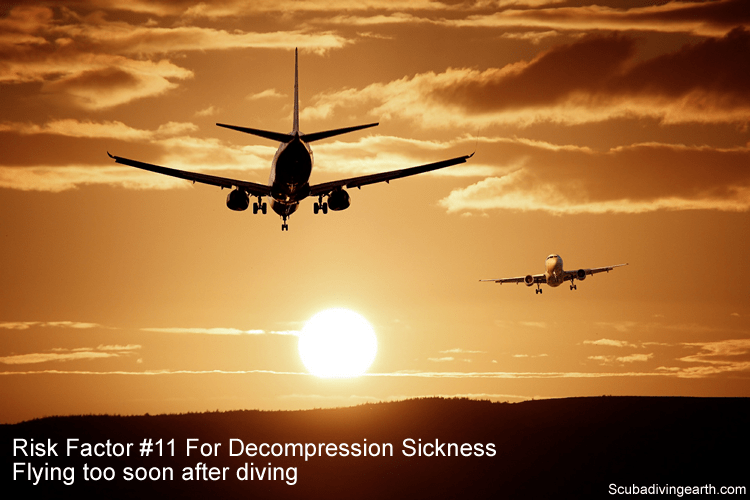
11. Flying too soon after diving increases your risk of decompression sickness
It is recommended you don’t fly for at least 24 hours after diving. If you use a dive computer this will normally tell you when it’s save to fly after your last dive. This will avoid you fizzing up on the plane when it takes off.
However, even if this is clear before 24 hours is up I recommend you are cautious and wait the full 24 hours.
The reason why it’s not recommend to fly with 24 hours is that higher up in the earths atmosphere, the atmospheric pressure reduces. Most aircraft fly at over 9,000 metres (30,000 feet) or more.
At this height, which is roughly the height of Everest, the pressure drops by about 30 percent. That means if you’ve just scuba dived and you still have nitrogen in your body you could get the bends.
There are a few accidents involving decompression sickness (DCS) where scuba divers fly too soon after diving.
More Reading: How long should you wait to fly after diving? (What’s safe?)
How to avoid decompression sickness risk factor #11
If you know you going to be flying, never dive on the day of the flight. Plus, always do your last dive on the day before at least 24 hours before the flight is due to take off on the following day.
More Reading: What should you not do after scuba diving (11 must NOT do’s after diving)
12. Being female and the menstrual cycle increases your risk of decompression sickness
Decompression sickness in women and a possible relationship with the menstrual cycle is worth taking note of if you are a female scuba diver.
There is still a limited amount of research and evidence that there may be a relationship between altitude decompression sickness (DCS) and the menstrual cycle.
How to avoid decompression sickness risk factor #12
Whilst there are limited diving studies to support these findings, I suggest that if you are a female diver and you are in your menstrual cycle at the time of scuba diving, you take more care and be more cautious in your approach to decompressing.
13. Cold water diving increases your risk of decompression sickness
Thermal effects or temperature changes have an effect on inert gases, which in this case is nitrogen. A diver’s thermal status can substantially change inert gas exchange. But in particular the gas exchange on a diver’s ascent. The amount of uptake and elimination of nitrogen will impact on the decompression requirements for a given dive profile.
It’s therefore important to recognise that you may be safe under one set of conditions (say during a warmer-water dive) but then on a similar dive profile this may lead to decompression illness in another (on a cold water dive).
Dive computers do not take account of water temperature in the decompression calculation
It’s also important to note that although dive computers may display the water temperature on the dive, their algorithms don’t incorporate this temperature measurements into their mathematical model for computing decompression and bottom time etc.
How to avoid decompression sickness risk factor #13
The obvious answer would be to not dive in cold waters. But this isn’t a realistic option. Many scuba divers enjoy cold water diving. Myself included.
Therefore I suggest you take a few more precautions when it comes to decompressing on a cold water dive. Allow for more time on your ascent and don’t push the limits of your dive computer. Also, make sure to wear the right thermal insulation. For example, wear a drysuit rather than a wet suit in colder waters.
14. Lung disease increases your risk of decompression sickness
It almost goes without saying that if you have lung disease you are going to struggle going scuba diving in any event. I strongly urge you to seek medical advice if you suffer from any form of lung disease, asthma included.
Having lung disease will severely restrict the amount of gas-exchange and this will reduce your efficiency at body tissue oxygenation. But more importantly other gas exchanges like the removal of nitrogen from your body and blood stream.
How to avoid decompression sickness risk factor #14
Seek medical advice no matter what level of lung disease you have. However, if you get medical clearance to scuba dive don’t dive too deep and certainly consider very carefully before you even contemplate a decompression stop dive!
A final thought on the risks associated with decompression illness
Finally, as you’ll note, I’ve looked at each of these decompression sickness risk factors in isolation.
However, in real life this is never the case.
Be very aware and extremely careful if you are able to tick a number of the above ‘decompression sickness-risk-boxes‘ when it comes to planning your bottom time, dive ascent, decompression and stop times.
For example, if you are an older diver, who has put on extra weight, this means you are not at your peak fitness. If you combine that with being a smoker who’s had a skin-full of alcohol the night before, combined with a late night, so you’re now also fatigued. Having drunk loads of alcohol you are also potentially dehydrated.
Whilst this example is an extreme case, it’s a possible situation and creates a high risk scenario for decompression sickness.
My aim is for you to think very carefully about the things you do around scuba diving. And always, always do a safety stop on each and every dive at 5-6 metres (16-20 feet) for three minutes.
I hope you enjoyed this article about the 14 decompression sickness risk factors in scuba diving
I’d love to hear from you. Tell us about your adventures of diving and snorkeling, in the comments below. Please also share your photos. Either from your underwater cameras or videos from your waterproof Gopro’s!
If this article hasn’t answered all of your questions. If you have more questions either about snorkeling or types of scuba diving (or specifically about 14 decompression sickness risk factors in scuba diving), please comment below with your questions.
There will also be many more articles about scuba diving (and snorkeling) for you to read and learn about these fabulous sports.
Have fun and be safe!
#ScubaDCSRisk
More Reading: How do I get a dive buddy? (5 easy ways to find a dive buddy)


